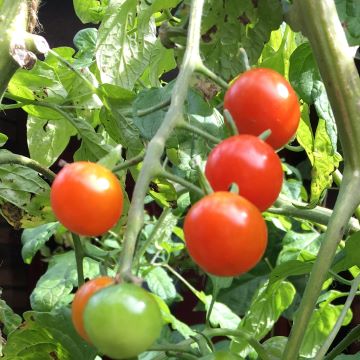It’s that time of year: tomato time.
Tomatoes are the number one vegetable grown by home gardeners in the western world. Gardeners are seeking that well-known and loved taste; the taste you just don’t get in store-bought tomatoes. But what do you need to know to begin growing tomatoes?
There are three main types of tomatoes:

most indeterminate varieties are small tomatoes
- determinate
- indeterminate
- semi-determinate
Determinate tomatoes are often called “bush’ tomatoes. They grow to their full size and produce all their fruit at one time. They are good for small spaces, growing in pots and are often used for preserving (bottling, sauces, drying).
Indeterminate tomatoes are often called “vine” tomatoes. They can grow to three or more metres, although 1.5-2 metres is more common, and will need some kind of support to grown on. They fruit over a long period of time.
Semi-determinate tomatoes are smaller than vine tomatoes. They crop over a longer period of time that bush tomatoes. They can be grown in large containers.
What is your purpose for growing tomatoes (apart from the taste)?
Before choosing the varieties of tomato you want to grow, first look at your purpose for growing tomatoes:
- salads?
- slicing?
- preserving: bottling, sauces, drying, etc
Then determine how much space you have and how much sun you have. Tomatoes are a fruiting crop so they need a lot of sun. This helps the sugars form and makes the tomato sweeter. However, tomatoes will not set fruit when the temperature goes over 35°C and you will need to provide some shade.
What do tomatoes need to germinate?
Tomatoes need a soil temperature of 20-26°C to germinate. They need well drained, “open” seed-raising or potting mix topped up with compost or old manure. They must be kept constantly damp but not wet. Waterlogged soil will rot the roots.
Sow seeds in a punnet or tray. When seedlings are about 2-3cm tall, plant them into their own pots. You can plant seedlings into the garden when they reach 10-15cm tall and when the danger of frost is passed. Tomatoes, unlike other seedlings, don’t mind being buried deep. You can remove the bottom pair, or even two pairs, of leaves and plant up to that point. Roots will grow from the leaf nodes which you have buried.
What do you need to do to keep your tomatoes growing?
Water your tomatoes regularly. The moisture content of the soil must stay as even as possible – not wet, not dry. If your soil is allowed to dry out then you water or it rains, fruit can split because of the extra water content available.

notice the splits on these tomatoes due to uneven watering
Feed your tomatoes with a fertiliser high in potash. This helps the fruit set and grow. Do not use high nitrogen fertilisers, such as poultry manure, or you will get leaves but little or no fruit.
Provide shade if the temperature is constantly over 35°C; especially if the night time temperatures remain above 25°C. At these high temperatures, pollen may become sterile and fruit will not set.
If we have another wet summer, which is possible, keep an eye on the leaves for fungal diseases if you see anything, remove the leaf and dispose of it. Do not put it in your compost or the fungus will spread. The best place for it is in a black container, (for example a plastic bag), and leave it in the sun to solarize. When the whole mass has turned black and stinky, you can then put it in your compost. If you don’t want to go to that extent, put it in the red (general waste) bin. if you place it in the green bin, you may spread the fungal spores throughout the community.
Plant flowers nearby to attract pollinators. Assist in pollination if the weather is humid. The higher the humidity, the more sticky the pollen becomes and will not fall where it is needed without your help.
Like every other plant in your garden, you should check regularly, preferably daily, for any signs of pests or diseases.
 Challenge:
Challenge:
There are over 50 varieties of tomato seed in the 2023 PSW Seed Catalogue: red, yellow, orange, ‘black’ and ‘white’. (Many don’t have photos: if you can help with that, please email Lynne.
What variety of tomato will you plant this season that is new to you? (Sorry: seeds are only available to members of PSW; please join first if you wish to purchase seed)
Please remember to return some of your seed to PSW Seed Savers to keep your Seed Bank alive!
Lynne
(PSW Seed Savers Coordinator)

